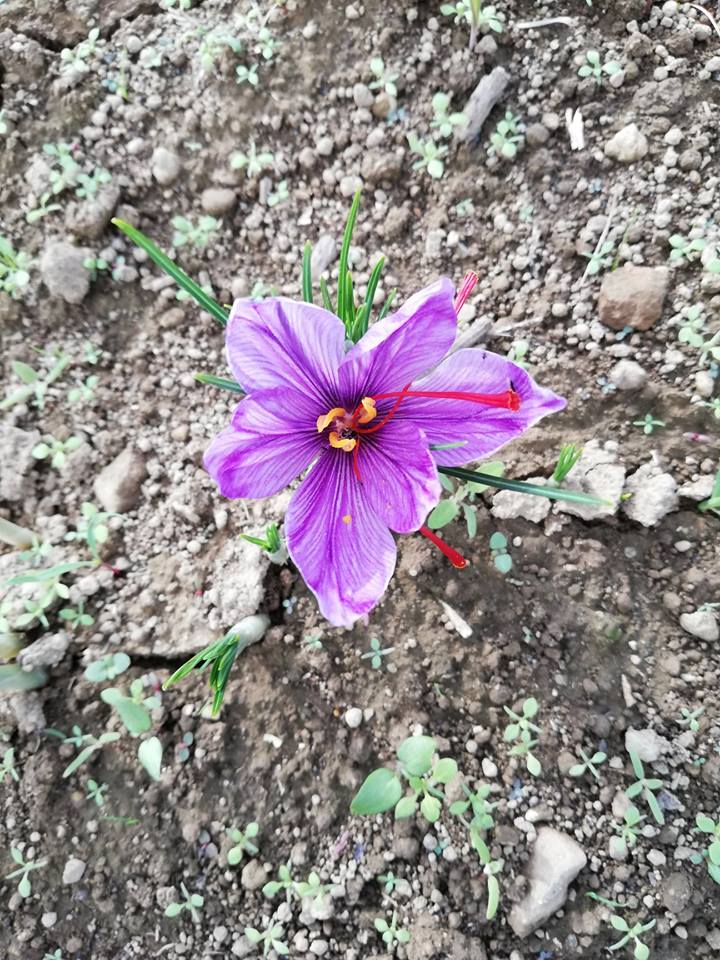
Saffron (Crocus sativus L.) is a spice with thousand virtues, in both cuisine and herbal therapy, esteemed as a useful remedy since ancient times.
Castore Durante, in his “Herbario nuovo” wrote:
“QUALITIES. It’s hot in the second degree and dry in the first, keeping in itself a little of cold and terrestrial, it opens, repercusses (*), digests, corroborates, and also mollifies. It is adulterated by mixing it with sapa (+), to make it heavier, or by pounding it with safflower: but smell and color allow to reveal the flaw.
VIRTUES. Internally. Saffron comforts the heart, purifies the blood, pushes poisons away from the heart, eaten or drunk, stimulates diuresis and menses, improves the complexion, if used with moderation. Drunk with sapa, it is useful against drunkenness, stimulates luxury, it is useful against jaundice, especially if drunk with sweet wine or malvasia. The root, drunk with sapa, stimulates diuresis, but a two-three drams dosage is mortally poisonous, and so it’s the flower, that is useful against weakness and ulcers of stomach, chest, liver, lung, kidney, and bladder, eaten in food: but the excessive use, and the smell, hurts the head, dulls the intellect, makes man pale, and makes him die laughing, by bringing too much joyfulness.
VIRTUES. Externally. It is useful for paralytic limbs, mollifies indurations of the nerves, and it’s used to make Oxycroceum, that is very useful to this purpose, it is useful mixed in eye powders, that are prepared for eyes, with woman milk, the seed of wild crocus, hand-ground, or suspended at the neck, is efficacious against bites of scorpions and it’s useful against the defects of the bottom and the matrix, put in poultices, and the same holds also for the infections of the ears. Chewing saffron, and then blowing on the face of sleeked women, make their face pale.”
And again Castore Durante, in his “Il tesoro della Sanità” (1590), tells:
“Choice. The best is the fresh one, well colored, and that has in its filaments a little white part, long, not fragile, full, that dyes the hands when wet, and that has a grateful smell.
Benefits. It comforts the stomach and the bowels, opens the oppilation of the liver, profits the spleen, produces a good complexion, removes putrefaction, induces sleep, excites to coitus, gladdens the heart, induces the menses and the urine, and facilitates delivery, but no more than two dram can be administered.
Harms. It goes to the head causing ache, drowsiness, dulling the senses, causes nausea, reduces the appetite, and administered in a too large amount, that is, up to three drams, is a poison that makes the person die while laughing, and its smell hurts the head.
Remedies. Use during the winter in small quantities, for elders, phlegmatics, and melancholics.”
And Mattioli adds:
“The crocus has a little astringency, that has in it some earthiness and coldness. But in it the hot quality is prevalent, so that all its essence reaches the second degree of hotness and the first degree of dryness; and it has a certain ability to induce maturation, ability to which its little astringency contributes. Indeed, all that remedies that are but not too hot and that have a little astringency have the same properties of the drugs that we call emplastic and maturative, that when conjoined with excessive warmth become concoctive […].”
Saffron purifies blood from melancholic and phlegmatic wastes, gladdens the heart (it’s antidepressive) and it is, according to the tradition, the most effective herb in treating measles and smallpox (see for instance “Culpeper’s English Physician; and Complete Herbal”).
(*) Sends humors (e.g., blood, body fluids) or a disease (e.g., scabies) back; sometimes with the meaning of resolving an inflammation or infection.
(+) sapa or vincotto is a liquid produced by slowly cooking and reducing unfermented grape must over a low fire.



